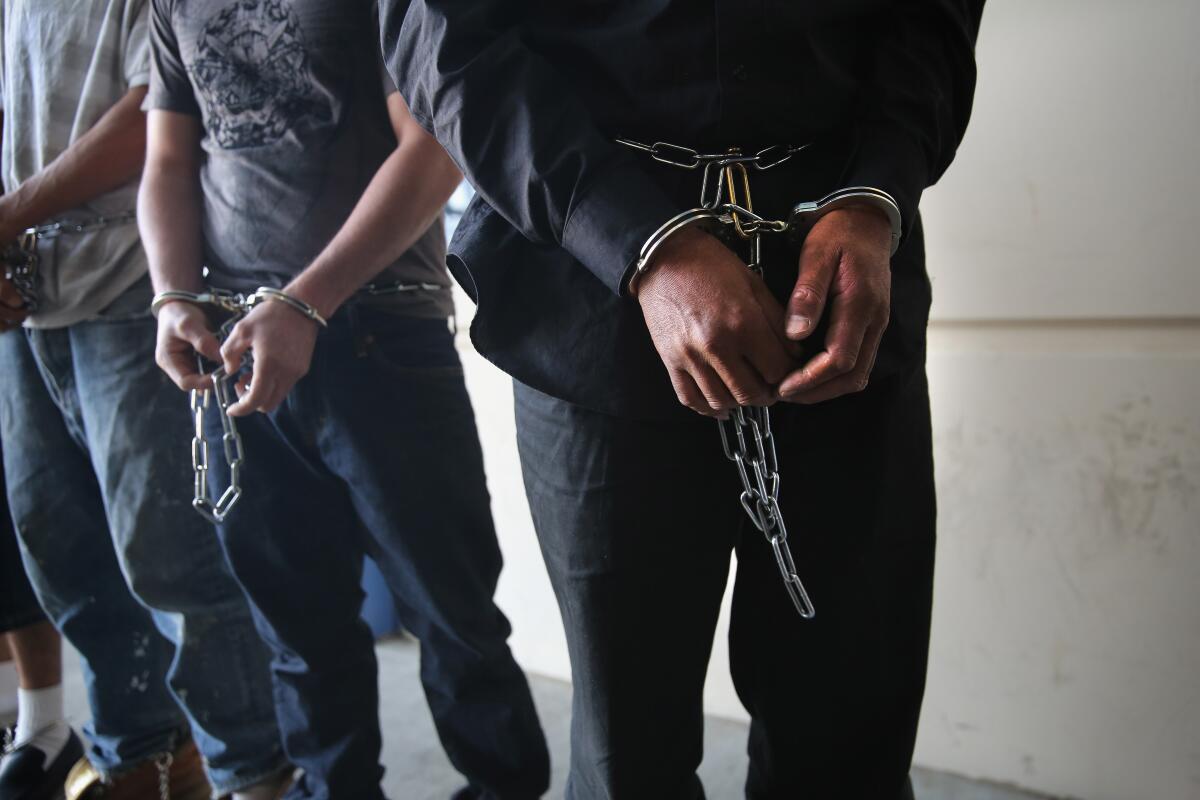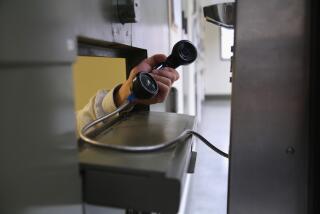Records show California prisons are reporting U.S. citizens to ICE, ACLU says

- Share via
WASHINGTON — On Aug. 18, 2022, a records department employee at the California Correctional Center emailed federal immigration authorities a list of people they believed could be subject to deportation. The list noted that most of those named were born outside the U.S. or had an unknown birthplace. But 12 people were listed as having been born in this country.
That email was obtained by the American Civil Liberties Union‘s Northern California affiliate and shared with The Times. The advocacy group says California Department of Corrections and Rehabilitation staff routinely assume people in their custody are deportable immigrants — even when their own records indicate they are U.S. citizens or immigrants who should not be deported — and report those individuals to U.S. Immigration and Customs Enforcement while denying them rehabilitation opportunities.
The records stem from a public records request filed last year by the ACLU affiliate, which sought communications between the California Department of Corrections and Rehabilitation, or CDCR, and ICE. The ACLU and other advocacy groups said they analyzed about 2,500 unique records from August and September 2022, during which the department transferred more than 200 people from its facilities to immigration custody.
The groups detailed the results in a report published Tuesday that they say describes the practices employed by the department in cooperation with ICE and provides examples of alleged actions by department staff that are discriminatory, including against immigrants.
“In their zeal to collude with ICE, CDCR is not only targeting people who have served their time and are set to return home for detention and deportation but is also sweeping up U.S. citizens and Green Card holders, relying on racist assumptions and ignoring their own records,” the report states.
Gov. Gavin Newsom’s office referred questions from The Times to the corrections department.
CDCR spokesperson Terri Hardy said the department is working to limit communications with ICE to only when someone enters prison and when their release date is approaching. Hardy said the department inquires with ICE for an official determination if staff can’t determine an individual’s place of birth or if information indicates that the person could be an immigrant.
ICE spokesman Richard Beam said the agency requests that California law enforcement notify ICE as early as possible of immigrants who are subject to deportation so that ICE can assume custody when they are released. He said those requests, called immigration detainers, conserve government resources and increase public safety by allowing arrests to be made in a secure setting instead of finding people for deportation within their community.
The report follows a lawsuit filed by the ACLU affiliate and former prisoners that alleged similar issues to those described in the records. In one example described in the suit, a woman born in California to Cambodian immigrants was referred to ICE because state prison officials wrongly perceived her to be a Mexican immigrant.
Records from the report appear to show some prisons have an “ICE Desk” with staff designated to facilitate referrals of incarcerated people to federal authorities.
According to the report, if a CDCR official perceives someone to be foreign born, that triggers a “potential” hold at intake — an internal designation established in the department’s operations manual. Once someone is marked with a potential hold, they are barred from lower-security custody placements, certain jobs and reentry programming.
Hardy said the CDCR is working on regulations that would allow incarcerated people with ICE holds to be placed in less-restrictive housing based on their behavior and program participation.
CDCR staff regularly put together “ICE packets” containing background information and criminal records of people they believe could be transferred to ICE custody, according to the report. Advocates said ICE often doesn’t begin investigating until a person’s earliest possible release date nears, sometimes with only days to spare. If ICE believes that person is subject to deportation, the CDCR issues an “actual” hold to show ICE’s intent to arrest the person upon their release, according to the department’s operations manual.
ICE has detained and even deported U.S. citizens. Last year, Asian Americans Advancing Justice — Asian Law Caucus and the ACLU affiliate settled a lawsuit with ICE over the unlawful detention of a U.S. citizen, Brian Bukle, who had been referred to the agency by the CDCR. Bukle repeatedly told ICE agents that he was a U.S. citizen while detained for 36 days at Mesa Verde ICE Processing Center in Bakersfield before an immigration attorney intervened and secured his release.
Sana Singh of the ACLU affiliate said the group has been reviewing records since February and expects to receive thousands more pages of records in the coming months.
“What’s reflected in these records is CDCR engaging in formalized discrimination,” she said. “We felt it was worth sharing now even before we get the full universe of records.”
Documents obtained by the ACLU affiliate showed that CDCR staff referred people to ICE despite the state’s own records showing they were U.S. citizens. In one email, a case record technician at Avenal State Prison referred a man to ICE whose records indicated he was born in California. The technician joked in an email to ICE agents inquiring about his legal status, “Should we just put US citizen on a piece of paper fold it up and put it in a hat, and then write on another piece of paper Mexican, fold it up and also throw that in the hat and pick one.”
In response to a question about the incident, Hardy said, “The email communication between a former CDCR employee at Avenal State Prison and ICE is unacceptable, and not in line with expectations for how our staff communicate and work with other law enforcement agencies.
“We are working to ensure our staff is properly trained and informed when dealing with these types of cases,” Hardy said. The CDCR did not respond to other questions from The Times.
In another email, sent by a correctional case records supervisor at San Quentin State Prison to an ICE deportation officer 11 days before a prisoner was scheduled for release, the supervisor said the inmate’s records indicated he was born in California.
But, the supervisor wrote, “He was not; he was born in Mexico.”
“May I ask what leads you to believe he was born in Mexico?” the ICE agent asked in response.
“His Probation Officer’s Report, as well as the information collected by the counselors when first received in prison, all state he was born in Mexico,” the supervisor replied. “I was tipped off while reviewing his parole audit … that he doesn’t speak English.”
Most people on lists sent by the CDCR to ICE whose birthplace is listed as the U.S. had non-Anglo-Saxon names, according to the report. ICE regularly sent back forms indicating that the person the CDCR had referred could not be deported, Singh said.
CDCR employees ask ICE if it would like to pick up a prisoner even without prompting from federal authorities, the records show, and have repeatedly followed up when agents did not respond. Sometimes, state officials held inmates beyond their release dates to verify if ICE wanted to arrest them, according to the report.
Hardy said the CDCR does not, and cannot by law, hold incarcerated people past their release dates.
A case records technician at Richard J. Donovan Correctional Facility indicated in one email that they would wait for a response from ICE before signing off on a prisoner’s parole.
In another instance, a case records technician at Chuckwalla Valley State Prison said a prisoner had declined to speak with ICE. Even so, the technician asked an ICE agent, “Do you still want to set an interview for him?” That appears to be in conflict with California law stating that such interviews are voluntary.
Ny Nourn, co-director of Asian Prisoner Support Committee, remembers being disqualified from a firefighting job and a cable wire harness manufacturing job because of her ICE hold. During her annual prison reviews, officials would tell her she was doing well — she said she received no write-ups or violations — but reminded her of the hold. Nourn, a green card holder born in Thailand to Cambodian refugees, was incarcerated for 16 years for her role in a murder committed by her former partner, who she said abused her, before being pardoned by Newsom.
After being released from the Central California Women’s Facility in 2017, Nourn spent six months fighting deportation.
“There’s many immigrants like me who have been transferred over to ICE,” she said. “CDCR is not about rehabilitation.”
She and other advocates are calling for California legislators to advance the HOME Act, which would block transfers to ICE detention of incarcerated people who meet the requirements for release under certain existing laws. Lawmakers rejected a predecessor of that bill last year.
Assemblymember Wendy Carrillo (D-Los Angeles), who sponsored the bill, said the documents obtained by the ACLU show clear bias that requires the Legislature to demand accountability.
“In actively collaborating with ICE and with their own discriminatory language and actions, CDCR has betrayed the public’s trust and their own mission to facilitate the successful reentry of individuals in their care,” she said.
More to Read
Get the L.A. Times Politics newsletter
Deeply reported insights into legislation, politics and policy from Sacramento, Washington and beyond. In your inbox three times per week.
You may occasionally receive promotional content from the Los Angeles Times.











